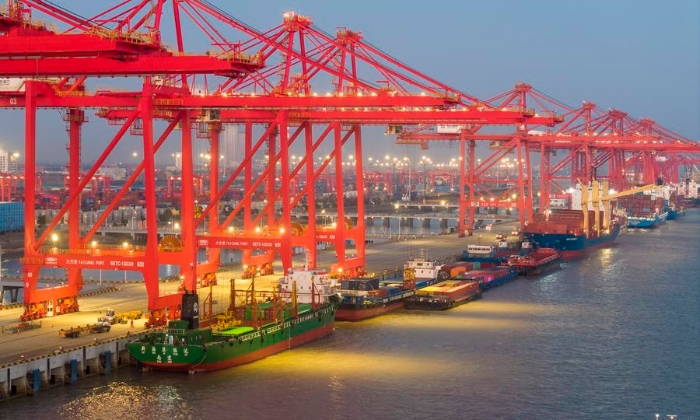Guest Opinion: 2024 economic data makes "China peak" theory supporters look foolish
2025-01-12 10:26:47 | Source:english.news.cn 2025-01-12

John Ross, former director of economic and business policy of London, receives an interview with Xinhua in Potters Bar, Britain, June 18, 2019. (Xinhua/Ray Tang)
by John Ross
As 2025 has begun, it is now possible to make a relatively accurate estimate of China's and other countries' economic growth in the last year. It is important that such assessments should be entirely accurate and realistic -- in serious matters exaggeration, in either an "optimistic" or a "pessimistic" direction, is harmful, and only accuracy and strict realism is useful.
China's annual Central Economic Work Conference in December noted that there had been a problem earlier in 2024 of "insufficient domestic demand." Not until the fourth quarter's economic figures are published will the results of the measures taken towards the end of the year be known. But figures for the first three quarters of 2024 are already published and make the fundamental situation clear -- there is also no indication that any fluctuation in either China or any other major economy in the last quarter of 2024 will have been large enough to alter the fundamental trend established during the earlier part of the year.
BRIEF COMPARISON OF CHINA'S AND U.S. GROWTH IN 2024
In the first three quarters of 2024, China's growth rate was 4.8 percent compared to the same period in the previous year. The only thing not yet published is whether China's growth rate in the year as a whole was 5 percent or slightly below. This, therefore, already makes it clear that this growth figure will be far higher than that of the United States -- the U.S. year-on-year growth rate in the third quarter was 2.7 percent and the IMF's estimate for U.S. full year growth, based on the first three quarters, is 2.8 percent.
The much faster growth in China than in the United States during 2024 makes clear the absurdity, and the purely propaganda character, of the claims in the U.S. media that China's economy was in crisis while the U.S. economy was experiencing great success. On the contrary, China's economy was continuing to grow far more rapidly than the U.S. economy in 2024.
A detailed examination of China's economic outperformance of the U.S. will be made later -- as soon as the two countries' end-year data is published by the end of January. More important, however, and considered in this article, is to analyze how far China's economic performance in 2024 was in line with its own strategic economic goals.

An aerial drone photo shows a view of Taicang port zone of Suzhou Port in east China's Jiangsu Province, Jan. 2, 2025. (Photo by Ji Haixin/Xinhua)
GOAL OF DOUBLING CHINA'S GDP BY 2035
Regarding China's economic development, the relevant strategic measure is the estimate adopted during the discussion at the beginning of the 14th Five-Year Plan. This noted that it was entirely possible to double China's GDP between 2020 and 2035.
To achieve this requires an annual average 4.7-percent growth rate between 2020 and 2035. During, and immediately following, the COVID pandemic, events such as lockdowns made purely short-term data exaggerated and unreliable in making comparisons. Therefore, it is preferable to take, in relation to evaluating performance against fundamental strategic goals, the period since the beginning of the pandemic as a whole. To avoid any suggestion of statistical "cherry-picking," both short- and longer-term data is therefore given here.
First, taking the period since before the beginning of the pandemic as a whole, data showed that between the third quarter of 2019 and the third quarter of 2024, China's GDP grew by 25.7 percent and U.S. GDP by 12.3 percent. That is China's economy grew by more than twice as fast as the United States.
In 2024, as already noted, it is clear from the first three quarters' figures that China's growth will come in at either 5 percent or very slightly below.
A 4.7-percent annual average growth rate from 2020 until the end of 2023, the rate required to achieve the strategic goal of doubling GDP between 2020 and 2035, would have yielded a total growth of 14.8 percent, whereas China's actual GDP growth was 17.5 percent -- that is, China was ahead of its target.
To achieve annual average economic growth of 4.7 percent up to the end of 2024 required China's economy to have grown during the period since 2020 by 20.2 percent. If China's economy grows by 5 percent in 2024, its total growth since 2020 will be 23.4 percent; if its growth in 2024 is only 4.6 percent, which is the annual average growth rate in the third quarter of 2024, China's total growth in the period 2020-2024 will be 22.9 percent.
Therefore, in either case, China's economy will have been growing faster since 2020 than the 4.7-percent average required to achieve the strategic goal of doubling GDP between 2020 and 2035.

A customer selects fruit at a supermarket in Zunhua, north China's Hebei Province, Jan. 9, 2025. (Photo by Liu Mancang/Xinhua)
SUMMARY OF 2024 INTERNATIONAL ECONOMIC RESULTS
To summarize, therefore, there are three fundamental clear conclusions regarding China's 2024 economic performance.
1. As the Central Economic Work Conference noted, there was a problem earlier in 2024 of "insufficient domestic demand." Whether the measures taken in the fourth quarter were sufficient to entirely overcome this will become clear when the end-of-year data is published.
2. Regardless of whether the measures taken in the fourth quarter turn out to have been fully sufficient to achieve the year's target of "around 5 percent," China's growth in 2024 will have ensured that it remains ahead of a strategic goal of achieving doubling of GDP between 2020 and 2035.
3. China's growth in the full year 2024 was given above both in terms of an extremely "pessimistic" estimate of 4.6 percent and an "optimistic" one of 5 percent. But either is much faster than the IMF's estimate of full year growth in 2024, based on the first three quarters of the year, of 2.8 percent for the U.S. economy, 1.1 percent for the EU, and 0.3 percent for Japan.

This photo taken on April 24, 2024 shows a new energy vehicle (NEV) assembly line of BYD, China's leading NEV manufacturer, at the plant of BYD in Zhengzhou, central China's Henan Province. (Xinhua/Li Jianan)
REAL ECONOMIC DISCUSSION VS PURE POLITICAL PROPAGANDA
In conclusion, despite the discussion of "insufficient domestic demand" earlier in 2024, China's economic growth rate continues to be significantly above a strategic goal of doubling GDP between 2020 and 2035 and far faster than those of the other major economic centers. These facts determine the real character of the real economic policy questions and debate in and about China.
This evidently does not mean there is no room for discussion within the framework of China's economic strategy -- precisely of the type seen at the Central Economic Work Conference in December. The present author personally believed it would have been preferable to take some stimulus measures adopted later in 2024 earlier -- in January 2024 he wrote advocating a reduction in interest rates and in a number of articles and interviews given during the year pointed to the key importance of paying attention to the question of, and increasing, company profitability. A range of views on such issues were put forward during the year in China and helped form the basis for the discussion at December's annual Central Economic Work Conference.
But from his own experience of being for eight years in charge of the economic policy of a major city, London, which is of course much less complex than a huge national economy such as China, the author knows the great difficulty of timing precisely economic measures and therefore the importance of focusing on strategic and fundamental parameters -- it is these which must be judged correctly for economic success and it is, therefore, those which are concentrated on here.
This type of inevitable legitimate economic discussion on specific features of economic policy is totally different to the type of pure political propaganda which has been appearing in the Western media and which, as is shown in detail above, is totally contradicted by the facts of China's and international economic development.
The only question regarding Western media who were writing in 2024 about "China peak" and similar issues is whether they were merely ignorant or conscious liars engaged in pure propaganda. Given the actual economic results for 2024, either way they should be ashamed of themselves.
Editor's note:
John Ross is a senior fellow at Chongyang Institute for Financial Studies, Renmin University of China. He was formerly director of economic and business policy for the mayor of London.
The views expressed in this article are those of the author and do not necessarily reflect the positions of Xinhua News Agency.
